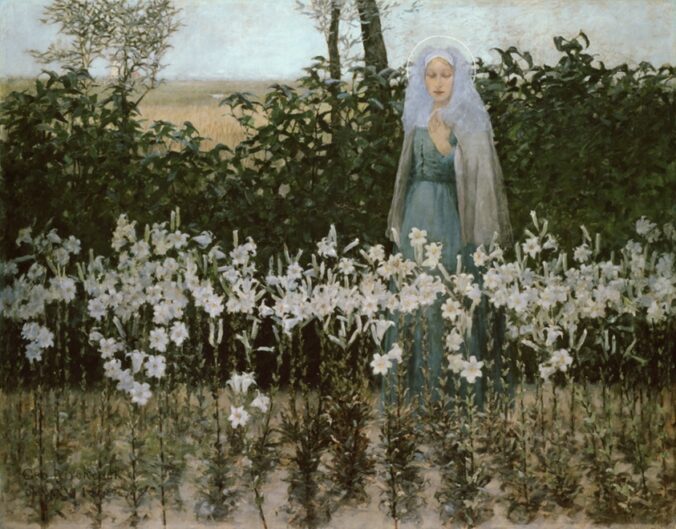Continuing on with Luke’s story of the revelation of Mary’s divine mission, the archangel Gabriel announces God’s plan for Mary’s life:
“‘And behold, you will conceive in your womb and bear a son, and you shall call his name Jesus. He will be great, and will be called the Son of the Most High; and the Lord God will give to Him the throne of his father, David; and He will reign over the house of Jacob for ever; and of His kingdom, there will be no end.'” Luke 1: 31-33
Although Mary is promised in marriage to Joseph, we know that she has also taken a vow of virginity, as a sign of her dedication to God. Among early Jews and Christians, vows of virginity were sometimes taken along with betrothals. These marriages offered protection for women who had taken such vows and, in some cases, also preserved social standing within communities. The Protoevangelium of James, an apocryphal text, also confirms Mary’s virginity and the marriage plan with Joseph.
But this historical context helps us to understand that Mary’s virginity alone is not enough to make her God’s ideal woman to give birth to and raise His only Son. There are certainly other virgins living at that time, who have dedicated their lives to God. Why does God choose Mary?
As we continue with Luke’s story, we observe Mary pressing Gabriel for details about how she will conceive:
“And Mary said to the angel, ‘How can this be, since I have no husband?'” Luke 1: 34
Gabriel responds with these words:
“And the angel said to her, ‘The Holy Spirit will come upon you, and the power of the Most High will overshadow you; therefore the child to be born will be called holy, the Son of God.” Luke 1: 35
We can only wonder what is going through Mary’s mind as she contemplates Gabriel’s announcement. To further validate that, with God, anything is possible, Gabriel also shares some amazing news about Mary’s cousin, Elizabeth:
“‘And behold, your kinswoman Elizabeth in her old age has also conceived a son; and this is the sixth month with her who was called barren. For with God nothing will be impossible.'” Luke 1: 36
Luke’s story reveals Mary offering her final decision to Gabriel, which implies that Gabriel is indeed awaiting her reply. Because God loves Mary, He gives her the free will to choose whether or not to accept His plan for her life.
Mary’s reply to Gabriel reveals why God has chosen her as the Mother of Jesus:
“And Mary said, ‘Behold, I am the handmaid of the Lord; let it be done to me according to your word.’ And the angel departed from her.” Luke 1: 31-38
God has chosen Mary for this divine mission because of her extraordinary humility.
In Mary’s reply to Gabriel, she describes herself as the “handmaid of the Lord.” A handmaid is a personal maid or female servant — someone whose essential function is to serve or assist.1 Mary recognizes fully that God has chosen her as His very human assistant in this divine mission. She does not credit herself for receiving the mission — she credits God as the singular and masterful architect of this Divine plan to introduce a Messiah capable of offering a new covenant to humanity.
Mary humbles herself further before Gabriel by saying, “let it be done to me according to your word,” confirming her complete agreement with and surrender to God’s plan, no matter the cost or burden to her personally.
Mary’s extraordinary humility invites God to work within and transform her life so that Divine Love and Mercy may take human form and enter the world.
It is through Mary’s humility that the Word becomes flesh and dwells among us. (John 1: 14)
The painting that appears at the top of today’s post poignantly depicts Mary’s humility and purity. The painting was created by the American artist George Hitchcock in 18872. The white lily is traditionally associated with Mary, symbolizing her purity and innocence. Within artwork depicting The Annunciation, the archangel Gabriel is also often shown offering a white lily to Mary, again as a symbol of her purity. The fact that the artist places Mary within an entire field of lilies, with downcast eyes and a physical stance that suggests both deference and openness, no doubt demonstrates Hitchcok’s desire to highlight the unrivaled purity and humility of Mary.
1https://www.merriam-webster.com/dictionary/handmaiden
2The Annunciation (1887), by George Hitchcock, today hangs in the Art Institute of Chicago.

Recent Comments